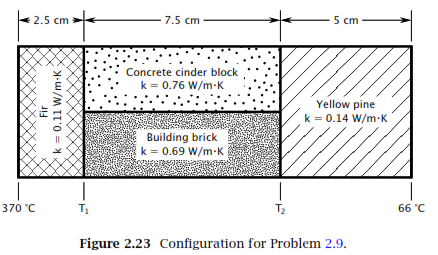Consider the composite wall shown in Fig. 2.23. The concrete and brick sections are of equal thickness. Determine T1, T2, q, and the percentage of q that flows through the brick. To do this, approximate the heat flow as one-dimensional. Draw the thermal circuit for the wall and identify all four resistances before you begin. Neglect heat flow through the interface between the brick and the concrete. Was it valid to treat the problem as one dimensional? [47.6% through brick]
Consider the composite wall shown in Fig. 2.23. The concrete and brick sections are of equal thickness. Determine T1, T2, q, and the percentage of q that flows through the brick. To do this, approximate the heat flow as one-dimensional. Draw the thermal circuit for the wall and identify all four resistances before you begin. Neglect heat flow through the interface between the brick and the concrete. Was it valid to treat the problem as one dimensional? [47.6% through brick]
Principles of Heat Transfer (Activate Learning with these NEW titles from Engineering!)
8th Edition
ISBN:9781305387102
Author:Kreith, Frank; Manglik, Raj M.
Publisher:Kreith, Frank; Manglik, Raj M.
Chapter2: Steady Heat Conduction
Section: Chapter Questions
Problem 2.50P: 2.50 Compare the rate of heat flow from the bottom to the top of the aluminum structure shown in the...
Related questions
Question

Transcribed Image Text:2.5 cm
7.5 cm
5 cm
Concrete cinder block
k = 0.76 W/m-K
Yellow pine
k = 0.14 W/m-K
Building brick
k = 0.69 W/m-K
370 °C
T1
T2
66 °C
Figure 2.23 Configuration for Problem 2.9.
Fir
k = 0.11 W/m-K
![Consider the composite wall shown in Fig. 2.23. The concrete
and brick sections are of equal thickness. Determine T1, T2, q,
and the percentage of q that flows through the brick. To do this,
approximate the heat flow as one-dimensional. Draw the thermal
circuit for the wall and identify all four resistances before you begin.
Neglect heat flow through the interface between the brick and the
concrete. Was it valid to treat the problem as one dimensional?
[47.6% through brick]](/v2/_next/image?url=https%3A%2F%2Fcontent.bartleby.com%2Fqna-images%2Fquestion%2Fbba194c6-539e-4b57-8637-e24c59390e39%2F6b39fd4e-71d5-4b54-9340-9dc057401bfe%2Fawhoozg_processed.png&w=3840&q=75)
Transcribed Image Text:Consider the composite wall shown in Fig. 2.23. The concrete
and brick sections are of equal thickness. Determine T1, T2, q,
and the percentage of q that flows through the brick. To do this,
approximate the heat flow as one-dimensional. Draw the thermal
circuit for the wall and identify all four resistances before you begin.
Neglect heat flow through the interface between the brick and the
concrete. Was it valid to treat the problem as one dimensional?
[47.6% through brick]
Expert Solution
This question has been solved!
Explore an expertly crafted, step-by-step solution for a thorough understanding of key concepts.
This is a popular solution!
Trending now
This is a popular solution!
Step by step
Solved in 2 steps with 2 images

Knowledge Booster
Learn more about
Need a deep-dive on the concept behind this application? Look no further. Learn more about this topic, mechanical-engineering and related others by exploring similar questions and additional content below.Recommended textbooks for you

Principles of Heat Transfer (Activate Learning wi…
Mechanical Engineering
ISBN:
9781305387102
Author:
Kreith, Frank; Manglik, Raj M.
Publisher:
Cengage Learning

Principles of Heat Transfer (Activate Learning wi…
Mechanical Engineering
ISBN:
9781305387102
Author:
Kreith, Frank; Manglik, Raj M.
Publisher:
Cengage Learning